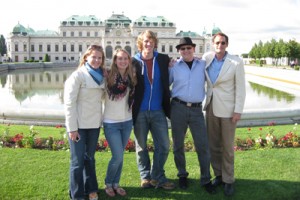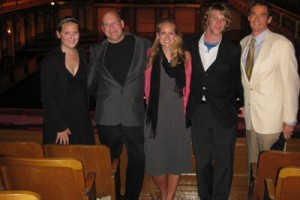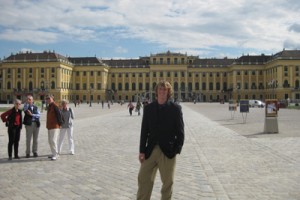My experience as a Rothkopf Scholar
By Banks Clark ’10
Banks Clark ’10 (Durham, N.C.), a double major in art and an individualized, interdisciplinary major in philosophy of religion, spent two weeks this summer studying the art of Vienna, Austria, as part of the Rothkopf Scholars program. Other scholars included art majors Emily Cushman ’10 (Wilton, Conn.) and Scott Lyttle ’10 (Easton, Pa.) and Hanna Pingry ’10 (Huntingdon, Pa.), a double major in art and geology. The trip was led by Robert S. Mattison, Metzgar Professor and head of art. The Rothkopf Scholars program is funded by an endowment established through gifts made to the Lafayette Leadership Campaign in honor of former Lafayette President Arthur J. Rothkopf ’55 and Barbara Sarnoff Rothkopf.
This past summer, I was graced with a rare opportunity, a 12-day trip to Vienna to be immersed in a vibrant artistic culture. Neither lyrical essay nor vibrant pictures could ever provide satisfactory explanation of the profound effects this experience provided. I was caught awestruck time after time as we traversed all of the cultural arts Vienna had to offer. We stood before masterpiece after masterpiece, witnessed virtuoso performances, walked through palaces and cathedrals, met local artists, and enjoyed many a fantastic meal. For me, however, I was most affected by the collaboration I experienced among a variety of disciplines and between student and professor.
Professor Mattison led us through Vienna, never needing even a pause to collect his thoughts, in an environment so ornate in history. I had never before experienced such a focused, in depth, and comprehensive exploration of the arts. We stayed in the city of Vienna for the entire trip, spending one day in the surrounding countryside, and as a result all of us started to become very familiar with the city. We could both give great explanations of culture and comfortably find our way to wherever we wanted to go. All of the students who went on the trip shared both deep enthusiasm and knowledge, resulting in meaningful and substantial conversation wherever we went. All of this combined with an agenda packed with museums, concerts, restaurants, and churches meant an ideal time to find where my deepest interest in art rested.
I remember Professor Mattison tracing the themes of Gustav Klimt’s visualization of Beethoven’s 9th symphony in the Beethoven Frieze. The trends drew from religion, music, Freudian psychology, and cultural taboos, many of which had religious implications. Experience after experience made me more and more aware of my own interests in art, modern thought, and religion. I even had the chance to visit the house of Ludwig Wittgenstein, a central modern analytic philosopher. Yet in all of these experiences, the most memorable for me was sitting in the royal chapel in the Hapsburg Palace for mass. As a Christian, a student of art, and a student of religion, I was caught in awe as the sounds of the Vienna Boys Choir resonated all through the room. During the entire trip, I was able to find overlaps between religion and art in new and interesting ways, imploring me to pursue this further.
Now that I am in my senior year, I am applying to graduate schools, and my experience in Vienna has greatly informed this process. I plan on going to graduate school to study modern theology, with a focus on how theology intersects with the arts (especially modern visual art). In Vienna the breadth of the art to which I was exposed honed my interest and solidified my confidence in the field of study I have chosen. Though I can only speak for myself, I know that I was not the only student who found great meaning and value though the Rothkopf scholarship. I can only hope that future participants will have equally profound experiences in their own travels.













